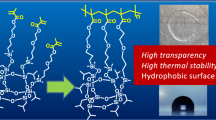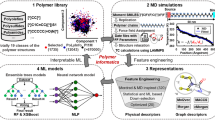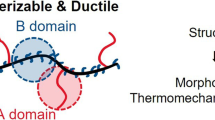Abstract
The polysilsesquioxane (PSQ) containing 3-aminopropyl and phenyl groups (APSQ) was prepared from the corresponding trimethoxysilanes by co-condensation under basic conditions. The amino groups on APSQ were used as the initiator species for the graft polymerization of 1,3-trimethylene carbonate (TMC) and L-(-)-lactide (LA). The ring-opening polymerization of TMC and LA in the presence of the catalytic 1-trimethylsilylimidazole proceeded effectively to afford the PSQ with poly(TMC) and/or poly(LA) as the graft chains. The grafted PSQ containing poly(LA) showed the heat durability as an advantage of the hybrid polymer. In differential scanning calorimetry analysis, the grafted random copolymer of TMC and LA showed no clear endotherm corresponding to melting point (Tm). For the poly(LA)-grafted PSQ, the peak indicating Tm was observed in the first heating run, but the corresponding peak was very small in the second run.
Similar content being viewed by others
Log in or create a free account to read this content
Gain free access to this article, as well as selected content from this journal and more on nature.com
or
References
Baney, R. H. & Cao, X. Silicon-Containing Polymers (eds Johns, R. G., Ando, W., Chojnowski, J.) (Kluwer: Dordrecht, 2000).
Baney, R. H., Itoh, M., Sakakibara, A. & Suzuki, T. Silsesquioxanes. Chem. Rev. 95, 1409–1430 (1995).
Kondo, T., Yoshi, K., Horie, K. & Itoh, M. Photoprobe study of siloxane polymers. 3. Local free volume of polymethylsilsesquioxane probed by photoisomerization of azobenzene. Macromolecules 33, 3650–3658 (2000).
Lee, J.- K., Char, K., Rhee, H.- W., Ro, H. W., Yoo, D. Y. & Yoon, D. Y. Synthetic control of molecular weight and microstructure of processible poly(methylsilsesquioxane)s for low-dielectric thin film applications. Polymer 42, 9085–9089 (2001).
Liu, H., Xu, J., Li, Y., Li, B., Ma, J. & Zhang, X. Fabrication and characterization of an organic-inorganic gradient surface made by polymethylsilsesquioxane (PMSQ). Macromol. Rapid. Commun. 27, 1603–1607 (2006).
Ciolacu, F. C. L., Choundhury, N. R., Dutta, N. & Kosior, E. Molecular level stabilization of poly(ethylene terephthalate) with nanostructured open cage trisilanolisobutyl-POSS. Macromolecules 40, 265–272 (2007).
Kawakami, Y., Yamaguchi, K., Yokozawa, T., Serizawa, T., Hasegawa, M. & Kabe, Y. Higher polyhedral silsesquioxane (POSS) cage by amine-catalyzed condensation of silanols and related siloxanes. Chem. Lett. 36, 792–793 (2007).
Pyun, J. & Matyjaszewski, K. Synthesis of nanocomposite organic/inorganic hybrid materials using controlled living radical polymerization. Chem. Mater. 13, 3436–3448 (2001).
Kim, K.- M., Keum, D.- K. & Chujo, Y. Organic-inorganic polymer hybrids using polyoxazoline initiated by functionalized silsesquioxane. Macromolecules 36, 867–875 (2003).
Cardoen, G. & Coughlin, E. B. Hemi-Telechelic polystyrene-poss copolymers as model systems for the study of well-defined inorganic/organic hybrid materials. Macromolecules 37, 5123–5126 (2004).
Fu, B. X., Lee, A. & Haddad, T. S. Styrene-butadiene-styrene triblock copolymers modified with polyhedral oligomeric silsesquioxanes. Macromolecules 37, 5211–5218 (2004).
Ohno, K., Sugiyama, S., Koh, K., Tsujii, Y., Fukuda, T., Yamahiro, M., Oikawa, H., Yamamoto, Y., Ootake, N. & Watanabe, K. Living radical polymerization by polyhedral oligomeric silsesquioxane-holding initiators: precision synthesis of tadpole-shaped organic/inorganic hybrid polymers. Macromolecules 37, 8517–8522 (2004).
Kashio, M., Sugizaki, T., Yamamoto, S., Matsuoka, T. & Moriya, O. Ring-opening polymerization of ɛ-caprolactone by base catalyst for synthesis of grafted polysilsesquioxane. Polymer 49, 3250–3255 (2008).
Kashio, M., Sugizaki, T., Yamamoto, S. & Moriya, O. Synthesis of grafted polysilsesquioxane by ring-opening polymerization of lactide. Polym. J. 41, 442–448 (2009).
Xu, J. & Shi, W. Synthesis and crystallization kinetics of silsesquioxane-based hybrid star poly(ɛ-caprolactone). Polymer 47, 5161–5173 (2006).
Hori, Y., Gonda, Y., Takahashi, Y. & Hagiwara, T. Ring-opening copolymerization of (R)-β-butyrolactone with cyclic carbonates: new biodegradable poly(ester carbonate)s. Macromolecules 29, 804–806 (1996).
Ruckenstein, E. & Yuan, Y. Molten ring-open copolymerization of L-lactide and cyclic trimethylene carbonate. J. Appl. Polym. Sci. 69, 1429–1434 (1998).
Zhang, Z., Zou, S. G., Vancso, G. J., Grijpma, G. J. & Feijen, D. W. Enzymatic surface erosion of poly(trimethylene carbonate) films studied by atomic force microscopy. J. Biomacromolecules 6, 3404–3409 (2005).
Kim, J.- H., Lee, S. Y. & Chung, D. J. Synthesis and properties of triblock copolymers from L-lactide and trimethylene carbonate. Polym. J. 32, 1056–1059 (2000).
Yang, J., Liu, F., Yang, L. & Li, S. Hydrolytic and enzymatic degradation of poly(trimethylene carbonate-co-D,L-lactide) random copolymer with shape memory behavior. Eur. Polym. J. 46, 783–791 (2010).
Endo, T., Kakimoto, K., Ochiai, B. & Nagai, D. Synthesis and chemical recycling of a polycarbonate obtained by anionic ring-opening polymerization of a bifunctional cyclic carbonate. Macromolecules 38, 8177–8182 (2005).
Bolton, D. H. & Wooley, K. L. Synthesis of polycarbonates by a silicon-assisted alkoxy/carbonylimidazolide coupling reaction. J. Polym. Sci. Part A Polym. Chem. 35, 1133–1137 (1997).
Kricheldorf, H. R., Lomadze, N. & Schwarz, G. Cyclic polylactides by imidazole-catalyzed polymerization of L-lactide. Macromolecules 41, 7812–7816 (2008).
Knight, P. T., Lee, K. M., Chung, T. & Mather, P. T. PLGA-POSS end-linked networks with tailored degradation and shape memory behavior. Macromolecules 42, 6596–6605 (2009).
Author information
Authors and Affiliations
Corresponding author
Rights and permissions
About this article
Cite this article
Kashio, M., Sugizaki, T., Tanaka, Y. et al. Synthesis of grafted polysilsesquioxane by ring-opening polymerization of lactide and trimethylene carbonate. Polym J 43, 525–530 (2011). https://doi.org/10.1038/pj.2011.22
Received:
Revised:
Accepted:
Published:
Issue date:
DOI: https://doi.org/10.1038/pj.2011.22



